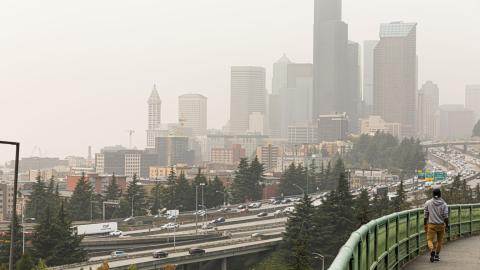More than 100,000 oil and gas wells across the western US are in areas burned by wildfires in recent decades, according to a new study by researchers from the University of California, Berkeley, the UW and six other institutions. Some 3 million people live next to wells that in the future could be in the path of fires worsened by climate change.
Researchers said their analysis, which was published recently in the journal One Earth, is the first to examine historical and projected wildfire threats on oil and gas facilities in the US. While the public health effects of scorched and damaged drill sites are unclear, researchers said the study is a necessary step toward understanding the potential compound hazards and could help inform policy about future drilling.

“We know that the burning of fossil fuels drives climate change. This study shows the pathway in the opposite direction, with climate-driven wildfires impacting oil and gas wells and potentially harming human health,” said Joan Casey, associate professor in the UW Department of Environmental & Occupational Health Sciences (DEOHS), and senior author of the study.
Exploring new environmental justice issues
“Most of the oil wells in California are currently in wildfire threatened areas, and a lot of people live in those areas because of the history of oil and gas development in this state,” said David J.X. González, an assistant professor of environmental health sciences at UC Berkeley’s School of Public Health. “The same issues that have been with us historically are still with us, and it looks like they might lead to new environmental justice issues that haven’t really been explored.”
González, the paper’s first author, pointed to Los Angeles and Kern counties as populated areas plumbed for oil and gas extraction and also at high risk of burning now or in the near future. In the past, fires in oil and gas fields not related to wildfires have caused blowouts, and leaks from gas storage tanks in Los Angeles have resulted in explosions that damaged buildings. Near Bakersfield, dozens of wells have been found to be leaking natural gas, some at explosive levels.
Since 1984, almost 350,000 people across the western US have lived within 1 kilometer of a well that was inside a burn zone, researchers found. Asian, Black, Hispanic and Native American people have faced disproportionately high exposure to those wells affected primarily by a handful of megafires in California, Texas and Oklahoma.
Facing the future
Across the West today, nearly 3 million people live within 1 kilometer of a well that is projected to be in an area with an increased risk of burning in the coming decades. What’s more, the number of wells in high-risk wildfire areas is predicted to nearly double by the end of the century.
That means more wells are being drilled in more areas expected to burn.
“I don’t want to say, ‘The sky is falling.’ But there was more of an impact than we thought there was going to be,” González said. “When we put everything together, it starts to look like this is a problem that hasn’t really been looked at in the past but has been worsening and will likely continue to worsen. It’s concerning, particularly for people living near leaking wells.”
“We brought together collaborators from engineering, social sciences, and public health to consider these intersecting hazards,” Casey said about the study. “Such ‘natech’ events — natural hazards triggering technological accidents — will likely increase with climate change and, as we observed here, disproportionately impact persistently disadvantaged communities.”
Adapted from the original post here.




